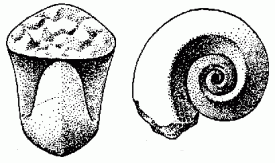
Cloudia buttsi Knight, 1947
diameter about 2.5 cm
Dolgellian of Laurentia (Alaska)
image © xxxx Knight, et al., 1960 p.I174
| Bellerophontoidea | ||
| Mollusca | Bellerophontoidea |
Conchifera
└─► |
|||
None |
Mollusca |
|
Helcionelloida (paraphyletic)
├─Paragastropoda
└─┬?─Tropidodiscidae
├?─Bellerophontoidea
└─Gastropoda (crown group)
╞═Eogastropoda
└─Orthogastropoda
|
Contents
Overview |
The Bellerophontoidea or Bellerophontida (traditionally Bellerophontina or Bellerophontacea[1]) are a fairly important group of Paleozoic mollusk fossils, characterized by a distinctive planospiral, symmetrically coiled shell, rather like a tiny nautiloid but without septa. They appear in the latest Cambrian, as part of the great molluscan evolutionary radiation of the time, reached their greatest diversity during the Ordovician and Silurian and continue through to the Triassic [Moore, et al. p.297].
All Bellerophontida have planispiral shells (and presumably symmetrical soft parts), but the degree of tightness of coiling varies. The more loosely coiled ones have a more or less open umbilicus on each side, and some forms, like the Pterothecinae, had such a wide aperture and so little coiling as to resemble modern slipper limpets (Crepidula). In the other extreme were extreme convolute genera of the families Euphemitidae and Bellerophontidae that lack umbilici and in which only the body whorl is visible from the exterior. This variation in shape indicates a variation in lifestyle of the living animal
Like most primitive gastropods, most Bellerophontids were probably algal grazers, although Linsley 1978 suggests that the advanced and cowry like Euphemitidae were fast-moving active predators and burrowers like the Caenogastropod Naticidae. Others, according to the geometry of the shell-form, were more sluggish, and some were intermediate in speed.
There is no evidence of an operculum associated with any Bellerophontida. It is [possible that in the absence of an operculum, the narrow aperture and deep withdrawal capabilities of advanced globular forms gave a strong selective advantage. Other Bellerophonts went the other direction, with wide apertures, and probably relied on clamping, like limpets and abalone, for protection [Linsley 1978]. Some may have been burrowers, hiding under the sand to escape predators.
As with a number of extinct groups, the Bellerophontids have a rather checkered taxonomic history. It is now pretty certain that as previously considered the Bellerophontida are a polyphyletic assemblage, including both gastropod (torted) and non-gastropod (untorted) forms. According to Wagner 1999, even the torted bellerophonts are diphyletic. As this is the latest research on the matter I have followed it here. Following this hypothesis, the order Bellerophontida can be considered a monophyletic taxon that developed from previous helically coiled "Sinuopids".
Note on cladogram: The very speculative cladogram used here is based on a sort of loose compromise of the cladograms in Wagner 1999 (Owenella antiquata, Cloudia buttsi, and Sinuites sowerbyi as outgroups only) and Wagner 2001 (has untorted cyrtonellids derived from torted tropodiscids and in turn giving rise to torted bellerophonts!) and on the Linnaean systematics of the Treatise [Knight, et al., 1960]. It may be more reasonable to derive the bellerophontids from late Cambrian or early Ordovician Tropidodiscids. We interpret untorted cyrtonellids as one of a number of lineages of untorted spiral-shelled conchiferans, see comments on Bellerophontiforms page MAK030304 revised 120617
Of the three suborders included in the Order Bellerophontida by Salvini-Plawin 1980, the Helcionellina are not gastropods, and Sinuitopsina is an inappropriate name, because Sinuitopsis is an untorted form (not a Gastropod). I would suggest replacing Sinuitopsina with "Sinuitina", remembering that this is a paraphyletic grade and hence of usefulness only for taxonomic purposes. The Bellerophontina is a monophyletic clade (apart of course from any forms that may be secondarily planospiral and hence not true Bellerophontida)
Golikov and Tarobogatov 1975 p.207 suggest that the structural diversity of the two bellerophont families Sinuitidae and Bellerophontidae of the Treatise [Knight, et al., 1960] is such as to justify a return to the arrangement of Wenz 1938, which they have accepted with some modifications for more recent discoveries (particularly two new families of Horny). I have followed a similar approach here, elevating a number of monophyletic or mostly monophyletic taxa that are considered tribes or subfamilies in the Treatise to the rank of family, while the large family Carinaropsidae is divided into several subfamilies. That gives about half a dozen new bellerophont families, which is not many considering that this was an important, diverse, and long-lived group.
Bellerophontida: - torted Bellerophonts
Stratigraphic Range: Furongian (Dolgellian) to Early Triassic
"Helcionelloida" : + Paragastropoda + Bellerophontida : Cloudia + Bucanellidae + Sinuitidae + Bellerophontina
Characteristics: according to Wagner 1999, secondarily planispirally, coiled , median anal emargination an open U-shaped sinus (becomes a slit in more advanced forms); paired retractor muscles, paired and equal ctenidia and osphradia (inferred by analogy with pleurotomariodea) [Knight, et al., 1960]
Taxon Rank: Order Bellerophontida McCoy, 1851
= Superfamily Bellerophontacea McCoy, 1851 in Knight, et al., 1960 p. I173
not Bellerophontina / Bellerophontida Ulrich & Scofield 1897, as that includes the non-gastropod
helcionellids
Notes: This important mostly Paleozoic clade includes the majority of bellerophont mollusks
Suborder Sinuitina: sinus-bearing Bellerophonts (paraphyletic grade)
Stratigraphic Range: Furongian (Dolgellian) to Permian
Notes/Characters: All Bellerophonts more basal than the Bellerophontina can be included under the paraphyletic suborder Sinuitina Dall 1913 (= family Sinuitidae in Knight, et al., 1960 p. I175), characterized by the plesiomorphic U-shaped sinus inherited from their Sinuopeid ancestors.
Families included: "Cloudiidae", Bucanellidae, Sinuitidae, Euphemitidae
Links: Early Archaeos
 |
Cloudia buttsi Knight, 1947
image © xxxx Knight, et al., 1960 p.I174 |
Cloudia: Cloudia buttsi
Stratigraphic Range: Furongian (Dolgellian Age)
Bellerophontida : Cloudia + Bucanellidae + Sinuitidae + Bellerophontina
Characteristics: Anterior lip with gently curved sinus; coiling close, with wide, steep umbilici; whorl section lozenge-shaped, with sharply rounded lateral angles; ornament unknown [Knight, et al., 1960 p. I174]
Notes: This extremely primitive bellerophont is included under the Cyrtolitidae by Knight, et al., 1960 but transferred to the Sinuitid Bellerophonts by Wagner 1999. It represents one of a number of short-lived Furongian forms
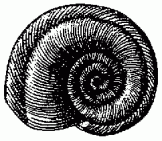
|

|
Bucanella nana Meek 1871
image © xxxx Knight, et al., 1960 p.I174 |
|
Bucanellidae: Owenella, Bucanella, Sinuella, and other forms
Stratigraphic Range: Furongian (Dolgellian Age) to Middle Permian [Knight, et al., 1960 p. I175]
Bellerophontida : Cloudia + Bucanellidae + Sinuitidae + Bellerophontina
Characteristics: Mostly small forms; Sinus relatively small; Shell phaneromphalus; ornament consists of fine, sharp collabral or spiral threads [Knight, et al., 1960 p.I175]
Taxon Rank: Family Bucanellidae Koken, 1925
= Subfamily Bucanellinae [Knight, et al., 1960 p. I175]
Notes: There is no guarantee that all members of this family actually belong here, although for the present if this primitive assemblage does indeed continue through to the Permian Knight, et al., 1960 it represents the longest lived family of Sinuitina.
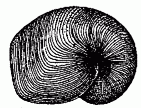
|
Sinuites bilobatus (Sowerby)
image © xxxx Knight, et al., 1960 p.I176 |
Sinuitidae: Sinuites sowerbyi and other species of Sinuites, Strangulites strangulatus, Selesinuites perneri, Ptomatis, Ctenistriella, and other forms
Stratigraphic Range: Furongian (if Anconochilus belongs here) / to Dolgellian Age) to Middle Devonian [Knight, et al., 1960 p. I175]
Bellerophontida : Cloudia + Bucanellidae + Sinuitidae + Bellerophontina ::: Euphemitidae
Characteristics: Sinus relatively wide [Knight, et al., 1960 p. I175]
Taxon Rank: Family Sinuitidae Dall, 1913
= Subfamily Sinuitinae in Knight, et al., 1960 p. I175 = Family Sinuitidae in Golikov and Tarobogatov 1975 p.207
Notes: The diagnosis given by Knight, et al., 1960 is not sufficient to define this taxon, which in the Treatise includes at least one non-gastropod (Sinuitopsis). However the cladogram of Ordovician Bellerophonts in Wagner 2001 shows a definite clustering of species of Sinuites and some related forms, so this probably is a natural group. Late surviving forms may have given rise to the Euphemetidae
Links: UGA Stratigraphy Lab - Sinuites
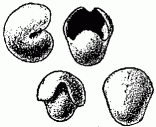
|
Warthia polita Waagan
image © McGraw Hill Book Company, from Moore, et al. 1952, pp.308-9 |
Euphemetidae: Euphemetites, Warthia
Stratigraphic Range: ?Devonian / Carboniferous to Permian [Knight, et al., 1960 p. I178]
tentatively: Sinuitidae ::: Euphemitidae
Characteristics: Shell globular, Sinus relatively narrow, becoming slit-like in more advanced forms; anterior lip thin, joining at a sharp angle the thick lateral lips; $ shell exterior covered by inductural layers (secondary shell deposits laid down on top of the primary shell) secreted by an anterior flap of mantle. [Knight, et al., 1960 p. I177]
Taxon Rank: Family Euphemetidae Knight, 1956
= Subfamily Euphemetinae in Knight, et al., 1960 p. I175] = Family Euphemetidae in Golikov and Tarobogatov 1975 p.207
Notes: as with the Bellerophontidae, these specialized forms, which may have evolved from the Sinuitidae, developed compact globular shells, with a lot of overlap between successive whorls, and resembling a tiny Nautilus
 But more than that, these highly advanced Bellerophonts were the cowries of the Palaeozoic. As with cowries, the mantle of the animal extended outside the shell to secrete an additional layer (or rather two or three layers, the inductura proper, perinductura, and coinductura forming a parietal thickening over the inductura within the aperture), which cover the entire exterior of the shell [reconstruction from Linsley 1978 p.200, left]. Quite probably in life the shell was glossy and brightly coloured, like modern tropical cowries.
But more than that, these highly advanced Bellerophonts were the cowries of the Palaeozoic. As with cowries, the mantle of the animal extended outside the shell to secrete an additional layer (or rather two or three layers, the inductura proper, perinductura, and coinductura forming a parietal thickening over the inductura within the aperture), which cover the entire exterior of the shell [reconstruction from Linsley 1978 p.200, left]. Quite probably in life the shell was glossy and brightly coloured, like modern tropical cowries.
According to Linsley 1978 the form of the shell indicates rapid locomotion, and (in contrast to other early gastropods, which seem to have been herbivores), these animals may well have been active predators. Linsey suggests an analogous mode of life with the Naticidae, in which the shell is also covered by the foot, and proposes that Euphemites may also have been similar in that it burrowed into sediment with its shell essentially internalized.
Bellerophontina: "higher" Bellerophonts
Stratigraphic Range: Early Ordovician to Early Triassic
Bellerophontida : Cloudia + Bucanellidae + Sinuitidae + Bellerophontina : Bucaniidae + "Bellerophontidea"
Characteristics: anal emargination generally consisting of slit [Knight, et al., 1960 p. I179]
Taxon Rank: Suborder Bellerophontina McCoy, 1851
= Family Bellerophontidae in Knight, et al., 1960 p. I179
Notes: This clade includes the majority of bellerophonts. To avoid fowling a slit, very like that of the Tropodiscida, developed. The slit is generally is present at the mid-point of the outer lip, and usually there is also a selenizone. It is formed by the sharply curved pattern of growth lines or "lunulae" and usually slightly raised or depressed surface can be found along the mid-line of the last-formed whorl. It is almost identical in appearance to the selenizone of pleurotomariid gastropods, which was one of the factors that led Knight and other workers to suppose a close relationship between the two, with the pleurotomariids as transitional between bellerophonts and higher gastropods. It is now known however that pleurotomariids, although a fairly primitive and unspecialized group that has changed little since the Mesozoic, are not the most primitive of living gastropods, and according to Wagner 1999 the pleurotomariid-type slit evolved independently among a number of Palaeozoic gastropod clades
If the cladogram of Ordovician Bellerophonts in Wagner 2001 is any indication, it appears that the evolutionary radiation of the Bellerophontina consisted of ((Tetranota + Carinaropsinae/etc) + (Bucaniides/etc + Sinuitidae). Of these two main clades, the "Bucaniides" dominated clade is here termed "Bucaniidae", and the Carinaropsine-dominated clade is here termed "Bellerophontidea". The Sinuitidae, which are included with the Bucaniidae in the Wagner 2001 cladogram, are here considered a more primitive group.
Bucaniidae: Bucania, Phragmolites, Megalomphala, Kokenospira
Stratigraphic Range: Early Ordovician to Devonian
Geographic Distribution: Laurentia, Armorica, Baltica, Asia, etc (= North America, Europe and NE Asia [Knight, et al., 1960 p. I180])
Bellerophontina : Bucaniidae + "Bellerophontidea"
Taxon Rank: Family Bucaniidae Ulrich &Scofield 1897
= Tribe Bucaniides in Knight, et al., 1960 p. I180] = Family Bucaniidae in Golikov and Tarobogatov 1975 p.207
Notes: This node appears in the cladogram of Ordovician Bellerophonts in Wagner 2001 as part of the "Bucaniides" dominated clade. It consists there of a number of forms mostly included in the tribe Bucaniides by Knight, et al., 1960 (e.g. Bucania, Megalomphala, Kokenospira) as well as Phragmolites which is according to Knight, et al., 1960 is included in the Tropodiscinae.
Bellerophontidea:
Stratigraphic Range: Middle Ordovician to Early Triassic
Phylogeny: : Bellerophontina : Bucaniidae + Bellerophontidea : Tetranota + Bellerophontoidea
This node appears in the cladogram of Ordovician Bellerophonts in Wagner 2001 as the Carinaropsid-dominated clade
Taxon Rank: Magnafamily Bellerophontidea McCoy, 1851
The new (informal) rank of Magnafamily is suggested by Dr Robert Schoch in his study of Perrisodactyls and elsewhere as an intermediate grade between "Parvorder" (beneath superorder) and Superfamily. It has the suffix -idea
[See Schoch, R. M. 1986, Phylogeny Reconstruiction in Paleontology, New York (Van Nostrand Reinhold); and See Schoch, R. M. 1989, A Brief Historical Review of
Perissodactyl Classification, in The Evolution of Perrisodactyls (ed D.R. Prothero and R.M. Schoch) Oxford University Press, New York, p.19
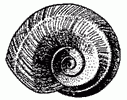
|
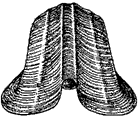
|
Tetranota bidorsata (Hall 1847)
image © xxxx Knight, et al., 1960 p.I178
|
|
Tetranota:
Stratigraphic Range: Middle to Late Ordovician
Phylogeny: : Bellerophontidea : Tetranota + Bellerophontoidea
Bellerophontoidea:
Stratigraphic Range: Middle Ordovician to Early Triassic
Phylogeny: : Bellerophontidea : Tetranota + Bellerophontoidea : Carinaropsidae + Bellerophontidae
Taxon Rank: Superfamily Bellerophontoidea McCoy, 1851
Notes: Includes the most advanced and specialized Bellerophonts
Carinaropsidae: Wide-aperture bellerophonts
Stratigraphic Range: Middle Ordovician to Devonian
Phylogeny: : Bellerophontoidea : Bellerophontidae + Carinaropsidae including Carinaropsinae : Grandostomatinae + Salpingostomatinae + Pterothecinae
Taxon Rank: Family Carinaropsidae Ulrich &Scofield 1897
= Subfamily Carinaropsinae in Knight, et al., 1960 p. I180
The Carinaropsidae could be divided into the following subfamilies:
Carinaropsinae - a paraphyletic assemblage of various unspecialized forms
Grandostomatinae - (no info at present)
Salpingostomatinae - with exhalent tremata
Pterothecinae - limpet-like forms
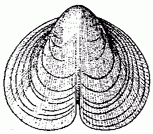
|
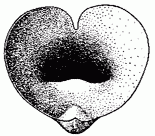
|
Phragmosphaera miranda Knight 1945
image © xxxx Knight, et al., 1960 p.I180
|
|
Carinaropsinae: Bucanopsis, Carinaropsis, Gyrospira, Phragmosphaera, Sphenosphaera, etc
Stratigraphic Range: Middle Ordovician to Devonian
Phylogeny: : Carinaropsidae including Carinaropsinae (paraphyletic) : Grandostomatinae + Salpingostomatinae + Pterothecinae
Taxon Rank: Family Carinaropsinae Ulrich &Scofield 1897
= Subfamily Carinaropsinae in Knight, et al., 1960 p. I180 = Family Carinaropsidae in Golikov and Tarobogatov 1975 p.207
Grandostomatinae:
Stratigraphic Range: Ordovician to Silurian or Devonian (no further information)
Phylogeny: : Carinaropsidae including paraphyletic Carinaropsinae : Grandostomatinae + Salpingostomatinae + Pterothecinae
Taxon Rank: Subfamily Grandostomatinae
= Family Grandostomatidae in Golikov and Tarobogatov 1975 p.207
Notes: according to the cladogram in Wagner 2001, this is part of the Carinaropsid clade of Bellerophonts
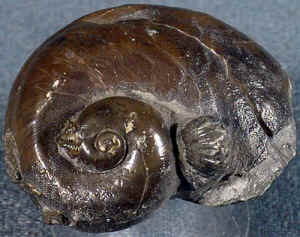
|
Salpingostoma richmondense
image from Ordovician HSU NHM |
Salpingostomatinae: Salpingostoma, Tremanotus
Stratigraphic Range: Middle Ordovician to Silurian [Knight, et al., 1960 p. I180]
Geographic Distribution: Laurentia, Avalonia, Gondwana, etc (= North America, Europe and Australia [Knight, et al., 1960 p. I180])
Phylogeny: : Carinaropsidae including paraphyletic Carinaropsinae : Grandostomatinae + Salpingostomatinae + Pterothecinae
Characteristics: $ Exhalent orifice or median emargination in the form of one or more tremata
Taxon Rank: Subfamily Salpingostomatinae Koken 1925
= Tribe Salpingostomides in Knight, et al., 1960 p. I180 = Family Salpingostomatidae in Golikov and Tarobogatov 1975 p.207
Notes: according to the cladogram in Wagner 2001, this is part of the Carinaropsid clade of Bellerophonts
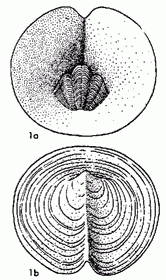
|
Aspidotheca schrieli Teichert 1935
image © xxxx Knight, et al., 1960 p.I183
|
Pterothecinae: Pterotheca, Cyclotheca, Aspidotheca, Pedasiola
Stratigraphic Range: Middle Ordovician to Middle Devonian
Geographic Distribution: Laurentia, Avalonia, Armorica, Euramerica, etc (= Europe and North America [Knight, et al., 1960 p. I182])
Phylogeny: : Carinaropsidae including paraphyletic Carinaropsinae : Pterothecinae Grandostomatinae + Salpingostomatinae + Pterothecinae
Characteristics: $ Widely expanding, somewhat limpet-like shell; $ spiral coil vestigial only; $ well developed plate within aperture (like Crepidula); selinozone on dorsal crest, ornament of growth lines only [Knight, et al., 1960 p. I181]
Taxon Rank: Subfamily Pterothecinae Wenz 1938
= Subfamily Pterothecinae in Knight, et al., 1960 p. I18 = Family Pterothecidae in Golikov and Tarobogatov 1975 p.207
Notes: According to the cladogram in Wagner 2001, this is part of the Carinaropsid clade of Bellerophonts, and in fact these Bellerophonts take to the extreme trends of wide aperture and reduced spiral initiated by the Carinaropsinae. The animal would seem to have lived by creeping about on soft fine-grained sediments (many specimens are in rock composed of such sediment) [Knight, et al., 1960 pp. I181-2]. Perhaps it was equivalent to a modern-day sea slug

|
Bellerophon graphicus Moore
image from Mollusca |
Bellerophontidae: Bellerophon, Aglaoglypta, Liljevallospira, Pharkidonotus, Prosoptychus, Ptychobellerophon, Ptychosphaera, etc
Stratigraphic Range: Middle Ordovician to Early Triassic
Geographic Distribution: Cosmopolitan
Bellerophontoidea : Carinaropsidae + Bellerophontoidea : Cymbulariidae + Knightiidae
Characteristics: Broadly rounded whorls giving a Nautilus-like shape; umbilici narrow or absent; ornament usually consists of growth lines only [Knight, et al., 1960 p. I179]
Taxon Rank: Family Bellerophontidae McCoy, 1851
= Subfamily Bellerophontinae in Knight, et al., 1960 p. I182 = Family Bellerophontidae in Golikov and Tarobogatov 1975 p.207
Notes: A characteristic feature is a deep sinus or slit at the aperture on the outer side of the coil. The umbilicus was narrow or absent, and the shell is ornamented by prominent growth lines (Knight et al. 1960). CKT110204, This is a large assemblage of advanced globose bellerophonts that survived throughout the Paleozoic to the early Triassic. Typical of the family is the long-lived cosmopolitan genus Bellerophon (Silurian to Triassic). As in the Euphemetidae, the shell has a low profile with many volutions which is accomplished by considerable overlap between the whorls.
Many specimens of Bellerophon show a "waterline" of inductural wash about half-way up the shell, suggesting that a great deal of mantle and foot were exposed during locomotion, and covered the exterior of the shell, as in the Cypraeidae and Naticidae. As with the Euphemetidae, these animals were probably quick moving, although those forms with strong ornamentation were not as swift. These animals were probably fast enough to avoid most predators and, when faced with the rest, depended on deep withdrawal into the shell for protection. [Linsley 1978 p.201] MAK030304
Cymbulariidae: Cymbularia, etc
Stratigraphic Range: Middle Ordovician to Silurian (Cymbularia) [Knight, et al., 1960 p. I182]
Geographic Distribution: Baltica, etc
Bellerophontidae : Cymbulariidae + Knightitidae
Characteristics: $ Last whorl strongly angulated and somewhat asymmetrical; narrow deep slit; umbilici closed on one or both sides; [Knight, et al., 1960 p. I182]
Taxon Rank: Family Cymbulariidae Horny 1963
= Family Cymbulariidae in Golikov and Tarobogatov 1975 p.207
Notes: Possibly the young was mobile like a conventional bellerophontoid but the adult lived a specialized, sedentary or semi-sedentary lifestyle
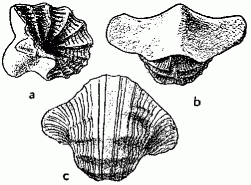
|
Cymatospira montfortiana (Norwood & Pratten)
image © McGraw Hill Book Company, from Moore, et al. 1952, pp.308-9 |
Knightitidae: Knightites, Retispira, Cymatospira, Patellilabia
Stratigraphic Range: ?Devonian to Middle Permian [Knight, et al., 1960 p. I183]
Geographic Distribution: Cosmopolitan
tentatively: Bellerophontidae : Cymbulariidae + Knightitidae
Characteristics: $ Strong spiral ornament (ridges) which presumably were the loci of cilia-bearing mantle folds that carried clean oxygenated water into the mantle cavity; $ advanced forms (Knightites) with tubes presumably from inhalant siphon; selenizone somewhat depressed; umbilici narrow; [Knight, et al., 1960 p. I183]
Taxon Rank: Family Knightitidae Knight, 1956
= Subfamily Knightitinae in Knight, et al., 1960 p. I183 = Family Knightitidae in Golikov and Tarobogatov 1975 p.207
Notes: Probably evolved from specialized Bellerophontids like Pharkidonotus.
note: in keeping with the convention of the Treatise authors of the volumes on Gastropoda and Cephalopoda, the suffix -ina is used for suborders only, and -ida for orders. Since the "Bellerophontina" as usually described would seem to be distinct enough to warrant ordinal status, the suffix -ina could be changed accordingly. For the unit as a whole however we have used the superfamilial ending -oidea, as this seems to be the designation used for the group in current literature.
page uploaded 4 March 2003
checked ATW051004
original material by M. Alan Kazlev (Creative Commons)
this material may be freely used
all other material © original authors or sources